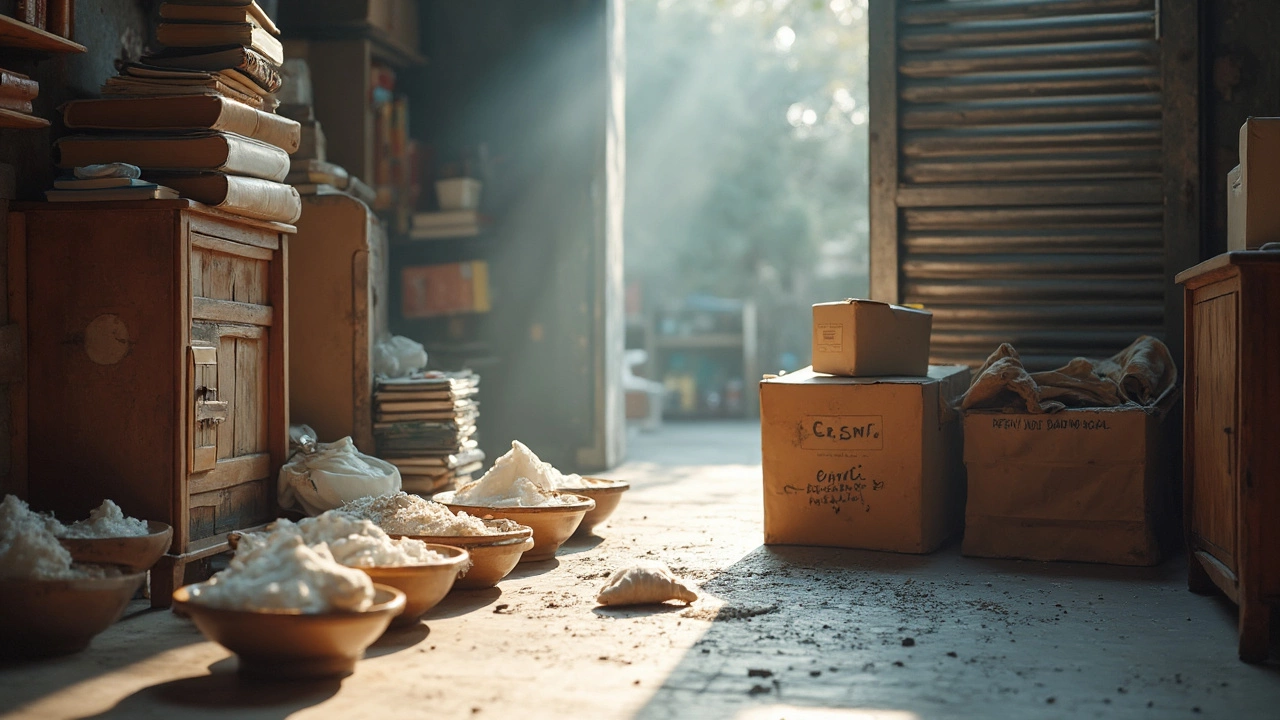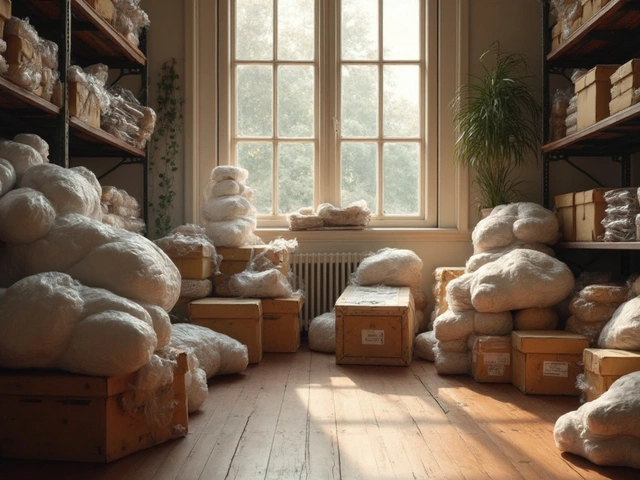 12
Jun,2025
12
Jun,2025
Nothing ruins a couch or a box of old photos quite like the smell of mildew. Storage units are basically moisture magnets, especially if you ignore the problem. A little condensation and bam—your stuff's musty, or worse, covered in mold. So, what actually keeps things dry?
You have solid options, from store-bought moisture absorbers right down to cheap DIY tricks. Silica gel packs? They work for more than just shoes. Those calcium chloride tubs look plain, but they’re moisture monsters. Even a handful of chalk sticks can help—bet you didn’t see that one coming.
The point is: you don’t need to spend a ton or run a dehumidifier just to keep your furniture dry. Tossing the right thing in your storage unit can save your stuff without much effort. And if you don’t know which choice works for you, stick around—there’s more on what absorbs best, weird hacks that won’t break the bank, and simple ways to make sure you never open a storage unit to a cloud of humidity again.
- Why Storage Units Get Moist
- Best Moisture Absorbers You Can Buy
- DIY Moisture Control Hacks
- Extra Tips to Keep Things Dry
Why Storage Units Get Moist
Ever opened a storage unit and got hit by that wet, funky smell? You’re not alone. Moisture is super common in these spaces, and it’s not just about the weather outside. Lots of things can make a storage unit damp, and knowing why helps you fix it—and avoid nasty surprises.
First, storage units aren’t totally airtight. Air sneaks in through tiny cracks and doors, dragging humidity from outdoors. When the air temperature inside drops—like at night or during cooler seasons—water in the air turns into droplets. That’s why your cardboard boxes might feel soggy, even if you never spilled anything.
Geography plays a part too. Live somewhere like Florida or Texas? The high humidity makes storage units prone to sweat, especially in summer. Indoor units can be a little better, but they’re not immune. One study by the U.S. Environmental Protection Agency found that areas with over 60% humidity see way more mold problems in storage than dry spots. Here’s how typical humidity looks for different states:
| State | Average Humidity (%) |
|---|---|
| Florida | 74 |
| Texas | 65 |
| California | 61 |
| Arizona | 38 |
Another biggie: what you put in your unit. Storing wet items, like freshly washed clothes or anything damp, guarantees trouble. Even sealed furniture can trap water inside and start a slow leak of humidity over time.
Here’s a tip from The Self Storage Association:
"The number one cause for mold in storage units is trapped humidity from wet or not fully dry items. Always air your belongings before packing them away."
- Check for leaks in the roof and walls before using a unit.
- Watch for water on the floor after rain—poor drainage is a sneaky culprit.
- If your unit is outside, expect bigger humidity swings with each season.
If you want your stuff to last, pay attention to moisture. A few smart moves early on can keep your belongings and storage unit way drier than your neighbors’.
Best Moisture Absorbers You Can Buy
Want to skip the guessing and go with the big guns? There’s a whole aisle of products made for sucking up humidity in your storage unit. Some are cheap and basic; others are a bit pricier but pack more punch. Let’s break down what actually works—and what’s a waste of money.
- Silica Gel Packs: These are the tiny, bead-filled sachets you find in new shoes and electronics. They’re low-key but reliable for pulling moisture out of the air. You’ll need more than a few though—toss a handful around anything you want to keep bone-dry, like boxes of photos or books.
- Calcium Chloride Containers: This stuff is a moisture vacuum. Look for brands like DampRid or Arm & Hammer Moisture Absorber tubs. They work by attracting water and turning it into a slushy liquid. Just set a few of these around your unit, check them every so often, and empty them when they fill up.
- Absorbent Dehumidifier Bags: These are basically big sacks filled with special crystals or beads. They hang easily or sit on shelves, and some come with color indicators so you know when to swap them out. They’re mess-free and easy to use.
- Reusable Desiccants: Some moisture absorbers can actually be “recharged” by tossing them in the microwave or leaving them in the sun. Products like Eva-dry come with built-in color changers so you know when they’re full. They’re pricier upfront but pay off if you’ll use your storage unit for years.
If you’re storing anything at risk for water damage—think upholstered furniture, paperwork, or wooden items—investing in one or more of these makes way more sense than gambling on good luck. For most small or medium units, two calcium chloride tubs and a few silica packs will do the job without breaking the bank.

DIY Moisture Control Hacks
Say you don’t want to splurge on fancy products or just like the idea of doing it yourself. Good news: you can tackle storage humidity with a few things often lying around the house. Some are classic tricks, and a few might surprise you.
Storage unit owners have been using cat litter to soak up moisture for decades. Yep, the cheap clay stuff is more than just for your cat box. Just dump a couple pounds in old socks or stockings, tie them off, and set them around your space. Change them out every month or so, especially if you start to notice a funky smell.
Another easy one is using charcoal briquettes. These aren’t just for the BBQ. Plain, non-instant-light charcoal soaks up moisture and odors. Toss a handful inside a coffee filter or an old T-shirt, tie it up, and hide it in the corner. It’s a budget method that actually works, and you’ll avoid the sticky mess that some other DIY hacks can leave.
You’ve probably heard about baking soda in the fridge. It pulls double duty in a storage space, too. Open a big box, set it on a shelf, and swap it out every month for best results. Just don’t expect it to handle huge floods; it works best for moderate dampness.
Got sidewalk chalk? Load up a small paper bag with regular white chalk sticks and hang or set it somewhere safe. The calcium carbonate naturally grabs onto moisture. Simple, clean, and super cheap.
“Even simple things like rice or salt in breathable containers suck up some humidity, but nothing beats silica gel or calcium chloride for serious jobs,” says Mike Hunt, a facilities manager with SafeLock Storage.
Here’s a quick breakdown of how these DIY hacks compare:
| Material | Cost per Month | Replacement Frequency | Best For |
|---|---|---|---|
| Cat Litter | $2-$5 | 1 month | General moisture, odor |
| Charcoal Briquettes | $2-$4 | 1-2 months | Odor, medium moisture |
| Baking Soda | $1 | 1 month | Light dampness |
| Chalk | $1-$3 | 2-3 months | Low humidity |
Just remember, none of these beat real industrial-grade absorbers for flood situations, but they’ll do just fine in the average, slightly damp storage unit. Try a mix of these hacks if you’re not sure how much moisture you’re dealing with. And always double up if you’re storing books, clothes, or anything especially touchy about mold.
Extra Tips to Keep Things Dry
There’s more to fighting humidity than tossing in a moisture absorber and hoping for the best. Want to give your stuff a real shot at staying dry? Here’s what actually works, straight from folks who've learned the hard way.
- Storage unit choice matters. Go for a place with decent insulation, and if possible, ask for an upper-level unit—these usually have less ground moisture sneaking in. If you’re really worried, climate-controlled units are basically a slam dunk for keeping humidity low, but they do cost extra.
- Cardboard boxes are cheap but act like a sponge—yikes. Switch to airtight plastic tubs for anything valuable or prone to absorbing water, like clothes, papers, or electronics.
- Don’t jam everything together. Give air some room to move around by leaving small gaps between your stuff and the unit’s walls. This makes it harder for condensation to build up and get trapped.
- Keep stuff off the floor with pallets or even a couple of bricks. Floors can get damp fast, especially if the unit is in a low spot or if there’s heavy rain outside.
- If you’re storing things long-term, check in now and then. If you spot beads of water or even just a musty smell, swap out your absorber or add more. Brands like DampRid actually say their tubs last up to 60 days, but that can drop fast in muggy months.
For anything that’s already got that humid smell, air it out in sunlight before it goes into storage. Sunlight kills mold spores and gets rid of that wet stink faster than anything else. These extra steps take a bit more effort up front but can save you a fortune in ruined furniture and lost memories later on.




